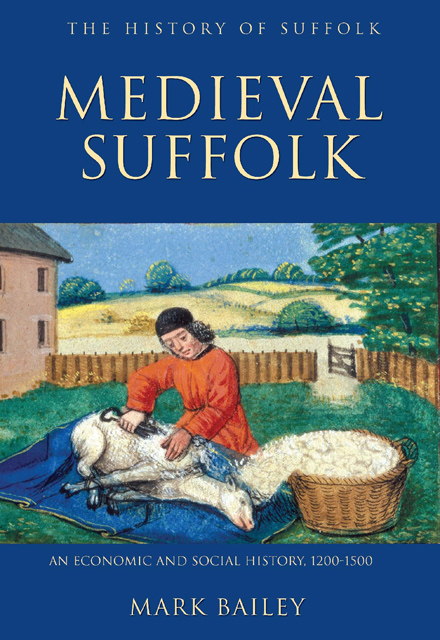Book contents
- Frontmatter
- Contents
- List of Plates
- List of Maps
- List of Tables
- Foreword
- Acknowledgements
- Note on Currency & Units of Measurement
- Abbreviations
- 1 Introduction
- 2 Landlords and their Estates, 1200–1349
- 3 Peasants and their Lifestyles, 1200–1349
- 4 The Agrarian Economy, 1200–1349
- 5 The Suffolk Landscape, 1200–1349
- 6 Towns and the Urban Environment
- 7 Commerce, Crafts and Industry
- 8 Pestilence, Rebellion and the Decline of Villeinage, 1349–1500
- 9 The Rural Economy, 1350–1500
- 10 ‘The World Turned Upside Down’: Rural Society, 1350–1500
- 11 Towns, Trade and Industry, 1350–1500
- 12 Conclusion
- Bibliography
- Index
8 - Pestilence, Rebellion and the Decline of Villeinage, 1349–1500
Published online by Cambridge University Press: 15 March 2023
- Frontmatter
- Contents
- List of Plates
- List of Maps
- List of Tables
- Foreword
- Acknowledgements
- Note on Currency & Units of Measurement
- Abbreviations
- 1 Introduction
- 2 Landlords and their Estates, 1200–1349
- 3 Peasants and their Lifestyles, 1200–1349
- 4 The Agrarian Economy, 1200–1349
- 5 The Suffolk Landscape, 1200–1349
- 6 Towns and the Urban Environment
- 7 Commerce, Crafts and Industry
- 8 Pestilence, Rebellion and the Decline of Villeinage, 1349–1500
- 9 The Rural Economy, 1350–1500
- 10 ‘The World Turned Upside Down’: Rural Society, 1350–1500
- 11 Towns, Trade and Industry, 1350–1500
- 12 Conclusion
- Bibliography
- Index
Summary
The Black Death
The Black Death erupted in southern England during August 1348 and had reached London by September. Using the internal evidence of manorial court rolls (which record the death of tenants) and bishop’s registers (which record the appointment of beneficed clergy to a parish), Jessopp concluded that the pestilence first reached East Anglia during the spring of 1349. His pioneering work was largely based on Norfolk, where some coastal communities were first hit in March and others closer to Norwich were struck in April and May: the pestilence was raging in central Norfolk in the high summer and early autumn, when it was also most active in Lincolnshire. More recently Benedictow has argued that the disease was already present in the Stour valley at the very end of 1348, but took another five weeks or so to develop into epidemic form in local communities. The earliest recorded outbreak of the epidemic in Suffolk occurs in January 1349, and it had largely passed by July, during which time it killed around one-half of the population. Contemporaries did not call this lethal disease the Black Death or plague: to them it was simply ‘the pestilence’. As a bald statement announced at the head of a manorial account for 1348–9 from Easton Bavents: ‘in which year the pestilence of men raged in England’.
Our knowledge of the local spread of the Black Death is still partial. Manor court rolls provide a sound basis for establishing the approximate date of the epidemic’s arrival in, and departure from, a locality, but complete series of courts from 1349 are uncommon. The manorial court held at Lakenheath on 11 February 1349 records the deaths of almost twenty tenants, and many more in the next court session in May. Similarly, one death is recorded in the January court at Worlingworth, eleven in the session on 30 April, forty-one on 8 July, and five in October. While it is not possible to date the arrival and passage of the epidemic precisely from such evidence, it is likely that it had arrived in lateJanuary at Lakenheath, raged during the spring and had passed by the early summer, while at Worlingworth it probably arrived in April and had passed by the end of July.
- Type
- Chapter
- Information
- Medieval SuffolkAn Economic and Social History, 1200-1500, pp. 176 - 203Publisher: Boydell & BrewerPrint publication year: 2007



